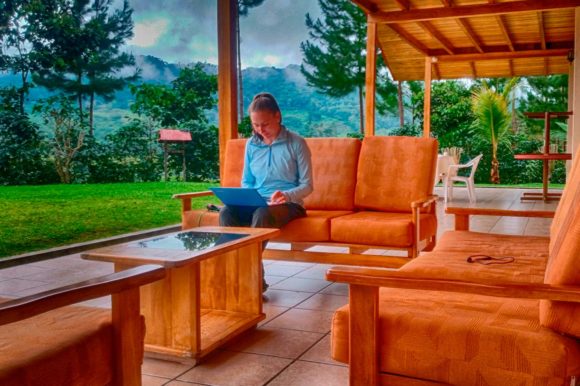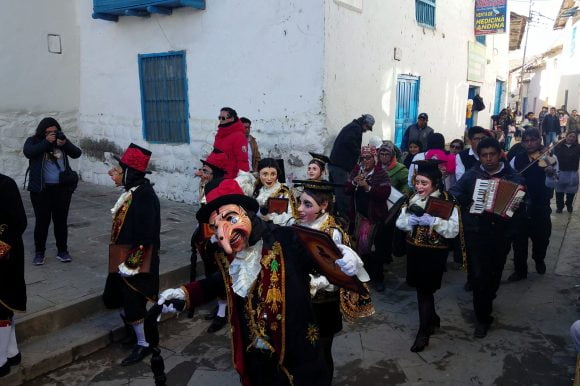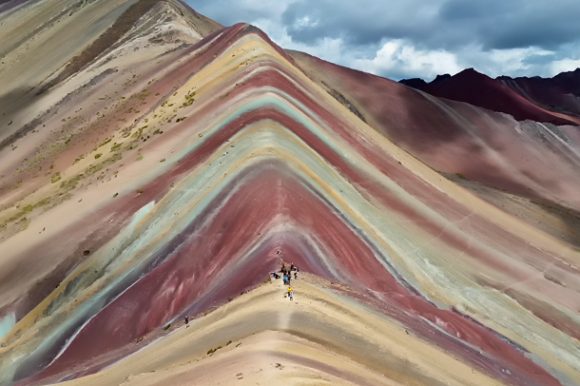You’re surrounded. The Plaza of Paucartambo, in a small town usually almost vacant, has quickly become a vortex of cultural expression and vibrant color…and you’re right in the middle of it. The smell of churros, fresh soups, and chicharron waft through the air, made even more tempting by the vendors beckoning you for a meal.
Passing through decoratively paved streets, a clamor of drums and trumpets interrupts your wandering. You react accordingly, stepping aside and watching as a dozen square hats fill the streets, blocking your vision. Beneath them are woven masks of white.
Dark eyes accent red mouths, above which yields burlesque mustaches. The ritualistic baby alpacas dangling over their shoulders and the decadence of their robes identify them as Qhapaq Qolla.
They are stepping together. The cheerful music boisterously leading the coordinated zigzagging. Beer is flowing, food is plentiful, and life is good. However, at the end of these four short days, the Qhapaq Qolla will be facing the multi-colored demons of hell, locked in battle and even giving their lives to protect their sacred one: Mamacha, the Virgin of Carmen.
…at least, that’s how the re-enactment goes.
Tradition brought to life
This is Paucartambo, where the festival dedicated to St. Carmen is held. From July 15th – July 19th, Peruvians from the entire country (and a few tourists) traverse the windy roads of the Andes. All to witness and pay respects to the beloved Saint of the Mestizos, also know as “Mamacha” or Virgin of Carmen.
Calling this festival organized would be an overstatement. However, while there may not be much of a schedule, there are several things you can expect:
- July 16th is the main day of the festival. A one-of-a-kind Mass is held at around 9 AM and the procession of the Holy Virgin is around 3 PM.
- The town will be packed with visitors, both camping overnight and visiting for the day. Tents are everywhere!
- There will be no shortage of food and snack vendors. Yet you may find the options limited to 4-5 different varieties.
- The nights are crazy. Nothing short of a costumed, firework-laden, beer-filled party!
- The whole festival is full of events, people to meet, and interesting stuff to see. During the days, 19 different troupes, or comparsas, of costumed characters dance through the streets, performing choreography depicting Peruvian/Andean heritage.
7 characters you will see at the Festival of Paucartambo
1. Maqta
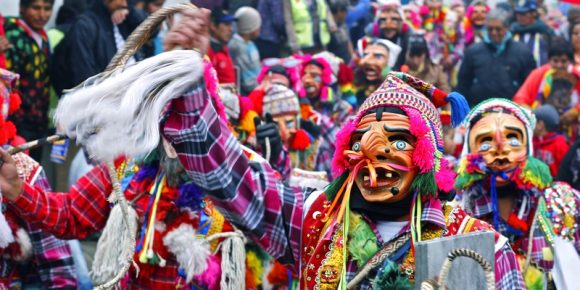
The name meaning “young peasant”, these characters are the only ones to not participate in any coordinated dances. Instead, they choose to wander around freely, often causing mischief.
- They interact with visitors frequently, playing around and making jokes in a falsetto Quechua voice.
- You will see even the children, Maqta, carrying around whips and striking them on the ground to make snapping noises.
- Often, they precede other troupes, clearing the way for the dancing. They lead during the Virgin’s procession on the 16th, making sure that visitors are removing their hats and showing respect.
2. Qhapaq Chuncho
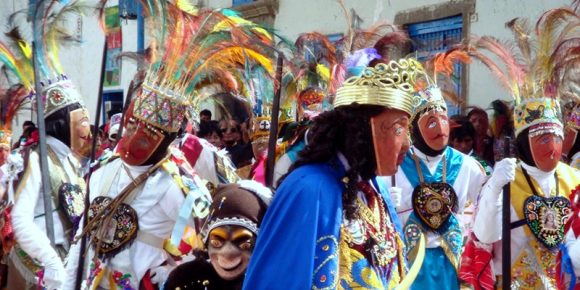
The rich Chuncho, the favorites of the Virgin of St Carmen, are easily recognized by the meticulously arranged troupes they arrive in and the plum of tropical birds adorning their heads.
- They represent tribes of the Manu Jungle that were conquered by the Inca, and integrated into the Antisuyu region (1 of 4 Inca Regions)
- A highly privileged group of Qhapaq Chuncho accompany the Blessed Virgin during the town procession, guardians of her journey.
- They participate in the final warfare ritual alongside the Qhapap Qolla.
- According to tradition, their absence from the festival leads a year of bad luck for the region.
3. Qhapaq Qolla
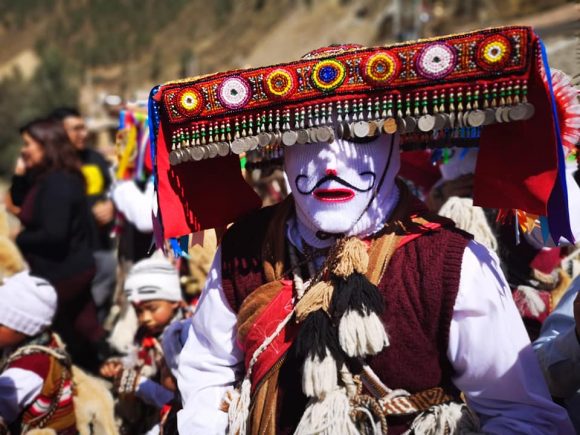
Representing the highland merchants from the Qullasuyu region of the Inca Empire, it is considered an honor to adorn the white mask and square hat of Qhapaq Qolla.
- Only natives of the town of Paucartambo can be considered in the choosing of the Qhapaq Qolla.
- Additionally, before a member’s hazing/initiation can begin, they must make a pilgrimage to the Lord of Quyllur Rit’y on Ausangate Mountain.
- Their merchant history is seen by the alpaca, carried limp on their backs. This tradition is a homage to the pack animals originally used to carry supplies to the Qhapaq Chuncho of the lowlands
- They are one of the few dancers who present the Mamacha with songs. As they sing, they share their happiness, honor her, and tell of the difficult journey they made to get there.
- The warfare ritual is led by the Qhapaq Qolla, defending their precious St. Carmen from those who would try and harm her.
4. Qhapaq Negro
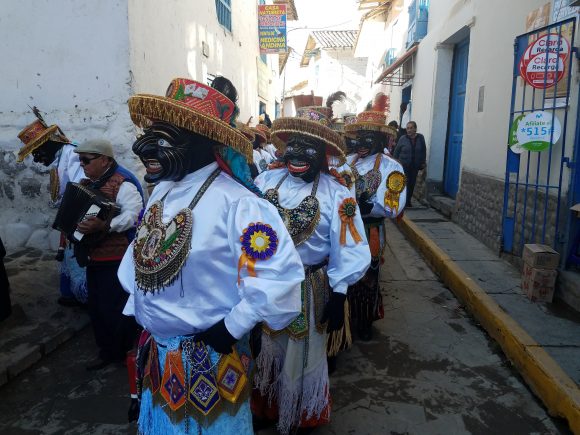
With intricate crests adorning their robes and dark features highlighted by gold, the Capac Negro pay honor to the slaves who were sent across the Atlantic and brought to work from Bolivia.
- Being taken to the Paucartambo region, they ended up as miners of the abundant gold and silver of the mountains. Their name literally means “rich negro.”
- The Capac Negro are one of the only two troupes (along with the Qhapap Qolla) that have the privilege to perform songs for Mamacha, and are known by their loving devotion to the Virgin.
- This costume has been present since the first St. Carmen festival and are considered, along with the Qhapaq Qolla and Qhapaq Chunchu, the most important troupes of the entire spectacle.
5. Majeño
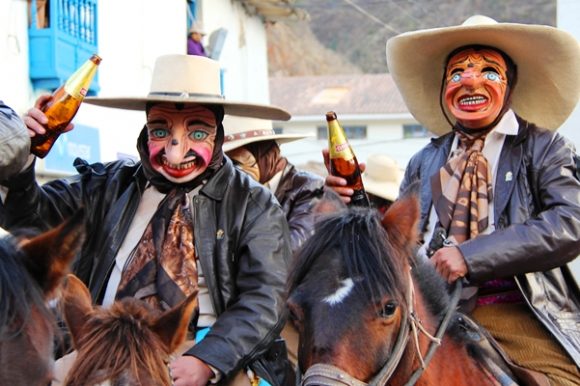
Dressed in leather coats, duo-toned ties, and large brimmed hats, these long-nosed participants’ less colorful costumes make them stand out among the troupes.
- They represent the Spanish conquistadors who roamed the geography of Peru, often making a living trading wine with the city of Arequipa.
- Frequently they are either riding on horseback or seen accompanied by a Spanish lady. She wears a traditional dress, braided hair, and a delicate-looking mask.
- Each member of their dancing troupe usually carries a bottle of Cusquena cerveza, which they joyously wave through the procession. Occasionally, they will halt their dancing to wildly loop the bottles around, spaying the crowd with sticky beer! You have been warned!
6. Danza Chucchu
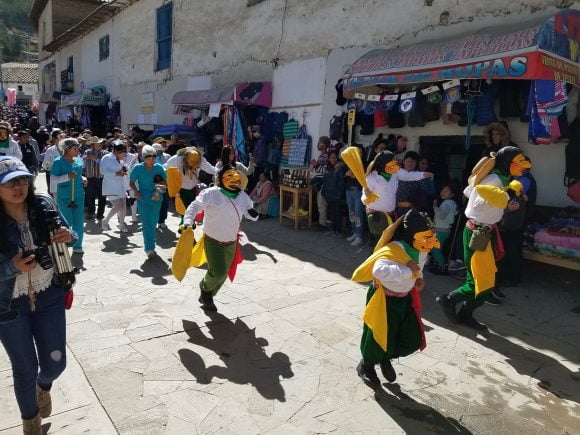
Some of the most interesting and frightening dancers of the festival, these dancers wear sickly yellow masks, often depicting physical damage or decay.
- They represent the Paucartambo villagers who were sent to extract rubber from the jungle, and were stricken with malaria.
- Roaming around the festival, they “share their ailment” with onlookers by lightly socking them with a bag full of yellow powder.
- Nurses accompany this troupe carrying comically sized syringes, occasionally pausing to “heal” the unfortunate malaria victims.
7. Saqra
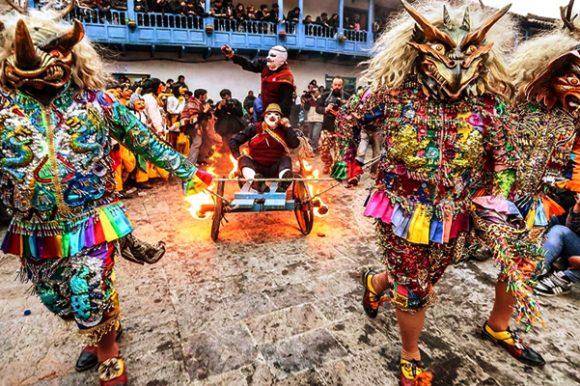
Saqra means “devil” or “evil” in Quechua. These colorful characters are dressed in the design of traditional Chinese demons, and are the adversaries of the virgin and tempters of the onlookers.
- When the main day’s procession of the Virgin is held, the saqra are close by. Vying for power, but unable to face her directly, they dart from balcony to rooftop, trying to maintain a close follow. However, whenever St. Carmen gets near, they cover their faces and skirt away.
- They are the main part of the final day’s malatya escort war ritual, battling and carrying the “dead” troupe members on wagons into the afterlife.
Cultural immersion at its finest
The festival of Paucartambo is an experience like no other, and St. Carmen is central to modern Andean culture. If you are able to speak Quechua, talking with locals will reveal the şirinevler escort significance and history behind every troupe and dance performed. Every culture has a way of expressing their identity and heritage, but Paucartambo does it like nobody else!
During the festival days, Daspe Travel offers a five-day tour to the nearby Manu Rainforest, with the first day spent at the main day of the festival of Paucartambo. izmit escort

